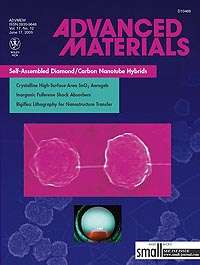Argonne researchers create new diamond-nanotube composite material

Researchers at the U.S. Department of Energy's Argonne National Laboratory have combined the world's hardest known material – diamond – with the world's strongest structural form – carbon nanotubes. This new process for “growing” diamond and carbon nanotubes together opens the way for its use in a number of energy-related applications.
Image: COVER STORY – Argonne's carbon-nanotube research was featured on the June 2005 cover of the peer-reviewed journal, Advanced Materials.
The technique is the first successful synthesis of a diamond-nanotube nanocomposite, which means for the first time this specialized material has been produced at the nanometer size – one-millionth of a millimeter, or thousands of times smaller than the period at the end of this sentence.
The result established for the first time a process for making these materials a reality, setting the stage for several fundamental advances in the field of nanostructured carbon materials.
The resulting material has potential for use in low-friction, wear-resistant coatings, catalyst supports for fuel cells, high-voltage electronics, low-power, high-bandwidth radio frequency microelectromechanical/nanoelectromechanical systems (MEMS/NEMS), thermionic energy generation, low-energy consumption flat panel displays and hydrogen storage.
Diamond is called the hardest material because of its ability to resist pressure and permanent deformation, and its resistance to being scratched. Carbon nanotubes, which consist of sheets of graphitic carbon wrapped to form tubes with diameters only nanometers in size, are the strongest structures because they can withstand the highest tensile force per gram of any known material.
“Diamond is hard because of its dense atomic structure and the strength of the bonds between atoms,” said Argonne's John Carlisle, one of the developers of the new material. “The larger the distance between atoms, the weaker the links binding them together. Carbon's bond strength and small size enable it to form a denser, stronger mesh of atomic bonds than any other material.”
Diamond has its drawbacks, however. Diamond is a brittle material and is normally not electrically conducting. Nanotubes, on the other hand, are incredibly strong and are also great electrical conductors, but harnessing these attributes into real materials has proved elusive.
By integrating these two novel forms of carbon together at the nanoscale a new material is produced that combines the material properties of both diamond and nanotubes.
The new hybrid material was created using Ultrananocrystalline™ diamond (UNCD™ ), a novel form of carbon developed at Argonne. The researchers made the two materials – ultrananocrystalline diamond and carbon nanotubes – grow simultaneously into dense thin films.
This was accomplished by exposing a surface covered with a mixture of diamond nanoparticles and iron nanoparticle “seeds” to an argon-rich, hydrogen-poor plasma normally used to make UNCD. The diamond and iron “seeds” catalyze the UNCD and carbon nanotube growth, respectively, and the plasma temperature and deposition time are regulated to control the speed at which the composite material grows, since carbon nanotubes normally grow much faster than ultrananocrystalline diamond.
“Experimenting with these variables led us to the right combination,” said Argonne's Jeffrey Elam, one of the developers. Added another of the developers, Xingcheng Xiao, “It is possible that the plasma environment causes local charging effects that cause attractive forces to arise between the ultrananocrystalline diamond supergrains and the carbon nanotubes. If so, such hybrid structures could have interesting electronic and photonic transport properties.”
The next step is to develop patterning techniques to control the relative position and orientation of the ultrananocrystalline diamond and carbon nanotubes within the material.
“In addition, we hope to understand the structure and properties of these materials, particularly the mechanical, tribological and transport properties,” developer Orlando Auciello said.
The research was featured in the June on the cover of the peer-reviewed journal, Advanced Materials.
Source: Argonne National Laboratory
















